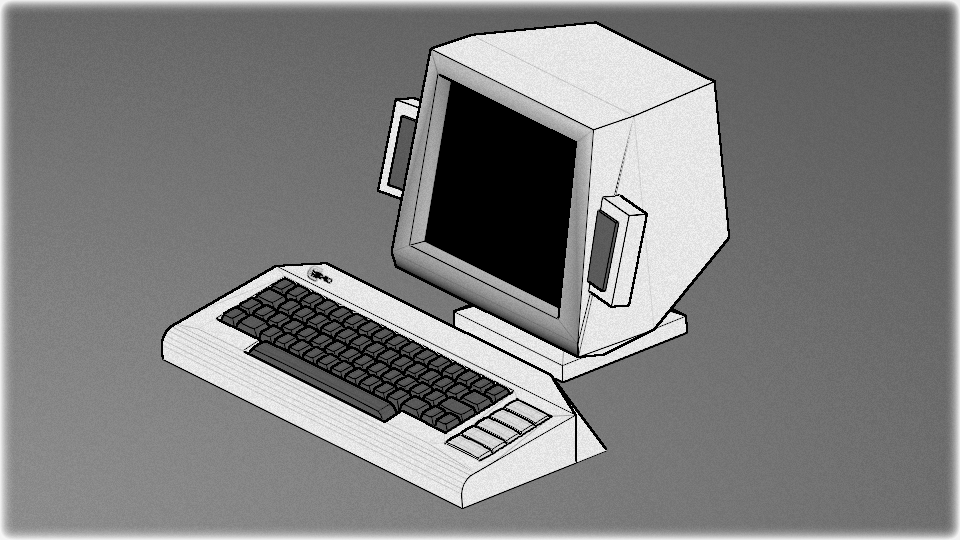In the year 1982, the Ensign International computer company could do no wrong. With the highly successful release of the Ensign 64 computer system (and the associated components), they were on top of the still young home computer market. Their tech was on top. Sales were up in both home and business sectors and across multiple international regions. Perhaps it was because of this success that they started to let their guard down. In 1985 many of the Ensign 64 engineers would be out of a job.
By 1984 sales were slipping to cheaper competitors. IBM was steadfast in tightening their own grip on the business world and Apple continued to push their own unique brand of computing to a kool-aid drinking userbase that seemed to grow exponentially with the upcoming Macintosh. More and more developers moved to DOS platforms or to Mac OS, ignoring Ensign’s BASIC interpreter. In the eyes of the Ensign loyal, something needed to be done, and Ensign’s own Mack Jamiel had abandoned them in a fit of frustration with Ensign’s board of directors and was now pursuing his secondary ventures.
Come 1985, Ensign was sinking. Wages were being cut as well as positions. The debts they owed far outweighed their revenue, and muddled leadership began to create internal complications that would lead to many of the staff simply quitting outright. Acting CEO Michael F. Smith followed suit, resigning his position entirely. This led many to assume the company would enter freefall, no job was safe. The Ensign family of computers would be coming to an end, or at least it would have been that way if it were not for the brave efforts of interim CEO Lawrence M. Rodriguez.
In a daring attempt to revive the dead, Rodriguez purchased a small government founded technology firm named Exalt. Knowing the board of directors would never approve a purchase with Ensign’s dwindling cash reserves, Lawrence funded it out-of-pocket, and while it would eventually lead to his own undoing, the fine work from the new Exalt branch helped propel the Ensign brand back into the hands and hearts of the average consumer, starting with the legendary Vic-30 home and business computer.
The Exalt team had been given full access to all design documents involving Ensign’s greatest hits, they were expected to produce a successor to the Ensign 64. However upon looking at the design documents for the machines, they decided on improving the older and unavailable Commodore Vic-20 instead. Ensign purchased the rights from Commodore for the use of the Vic naming prefix, a naming convention Commodore had left behind at that point. This proved to be an economic decision, many Vic-20 parts still remained in warehouses and they could be easily retrofitted to work with the incoming upgrades saving both production time and cost of materials. Since the 20 in Vic-20 is a nonsense number in itself, it only seemed natural to brand the new machine the Vic-30, simply a number bigger than 20. It was unclear as to why the Exalt team preferred the Vic-20 to the E64 beyond the economic reasons, but their methods were never questioned. They would deliver a product so revolutionary that it would transform the world of modern computing forever.
After 2 months without seeing any form of demonstration from the Exalt team, standing chairman of the board Isaac Gould demanded a progress report on the upcoming product from the Exalt team themselves, going to the lengths of driving out to their Nevada offices himself and knocking on their door. What he saw when he entered both astounded and terrified him. The prototype Vic-30 had been prepared for him alone in a small room with no other human to be seen. Then, the bizarrely shaped prototype sprung to life in full color “As vibrant and clear as a movie”, Gould would later say. The machine had been preloaded with an early form of a chat bot armed with both speech synthesis and early speech recognition abilities. the face of an attractive woman appeared on the screen, matching lip movements to the sounds that came out. Gould spoke with the machine, asking about its capabilities and components, of which the machine was completely knowledgeable but was reluctant to provide.
Gould stated in an interview with the New York Times in May 1985 about their upcoming projects; “The machine was less interested in telling me about itself than it was in asking me about my own life. She was genuinely interested in me, and what can I say? I was flattered. I let Exalt be. They’ve brought us our saving grace,” and so it was that the Vic-30 was nicknamed “Saving Grace” and “Amazing Grace”, but to many it was simply “Grace”.

The Vic-30 hit shelves just in time for Christmas 1985. The consumer model not only offered extremely high-resolution audio and video, it also made amazing strides in user-friendliness with it’s own new proprietary programming language named Flug which was designed for ease of use. Units came ready out of the box, with a 1024 x 768 display capability alongside a monitor with speaker “dumbo ears” on the sides, a new look for computing at the time. They were very networkable, including a high-speed modem in the chassis of the machine rather than a separate extension. This decision would help to lead the Ensign userbase into the first open internet communities, pioneering the World Wide Web as we know it today.
At extremely competitive pricing ($699) the machines flew off the shelves faster than any electronic device ever had before. They sold all 1 million preassembled units and preordered 750,000 more in the same week, overall selling approximately 12.5 million total units in 1986. With this sudden cash flow, Ensign was allowed to rise up once again and dominate the industry. But not all was well in the kingdom.
Things seemed too good to be true for the engineers at Exalt, and many accused them of theft and possible union manipulation to cover the costs of manufacturing. Several court cases were brought against the Exalt team from rival manufacturers for some extreme claims including usage of illegal technologies and copyright theft. One bizarre case also accused the engineers of using witchcraft. The terms of the Exalt branch included the anonymity of its members and complete autonomy apart from Ensign, there were many questions about whether or not engineers from other companies had been moonlighting for Exalt to get a slice of the pie. This controversy influenced Ensign’s board of directors to effectively close the deal with the Exalt branch in June of 1986. The identities of the Exalt engineers remain confidential to this day.
The closing of the Exalt offices had little effect on the phoenix-like rise of Ensign, in fact Ensign continued on to improve even further on the designs left for them by the team working on the Vic-30 and flourished into a figurehead of a new age of computing throughout the nineties and onward.
Many Grace machines are still in use, and Ensign remains the leading figure in computing to this day.
All images owned by Ensign or otherwise content produced by Fisher Wagg

